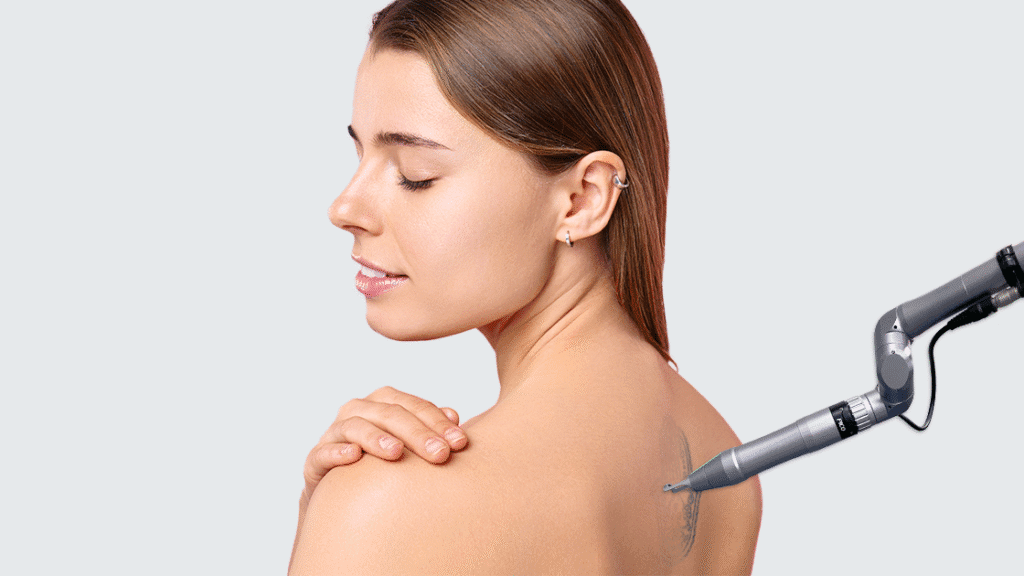1. Introduction: Understanding Tattoo Removal and Skin Safety
Tattoo regret has fueled rising demand for safe, effective removal options. Pico laser technology, the gold standard in tattoo removal, offers superior pigment clearance with minimal tissue damage. Unlike older methods, it targets ink precisely, reducing scarring risk and improving skin recovery. Understanding its mechanism and realistic results across different tattoo types and skin tones helps patients make informed decisions for achieving smoother, clearer, and scar-free outcomes.
1.1 The Growing Demand for Laser Tattoo Removal
En eliminación de tatuajes market has experienced exponential growth, with industry estimates projecting continued double-digit annual increases. Approximately 25-30% of tattooed individuals eventually seek removal or modification, motivated by employment considerations, relationship changes, lifestyle evolution, or aesthetic dissatisfaction. This demographic shift reflects broader social acceptance of tattoo removal as a routine cosmetic procedure rather than an embarrassing correction. Modern patients approach removal with research-based expectations, seeking evidence-supported technologies like Pico lasers. Professional advancement requirements often necessitate visible tattoo elimination, particularly in conservative industries. Additionally, the “tattoo cover-up” trend drives demand for partial fading before re-tattooing with improved designs.
1.2 Why “Scar-Free” Tattoo Removal Is a Common Concern
Historical tattoo removal methods, including surgical excision, dermabrasion, and early-generation lasers, frequently produced significant scarring, hypertrophic tissue formation, and permanent skin texture alterations. These outcomes often proved cosmetically worse than retaining the original tattoo, creating understandable patient anxiety. Scarring concerns particularly affect individuals with darker skin tones (Fitzpatrick IV-VI), who face elevated keloid and hyperpigmentation risks. The permanence of scarring versus temporary tattoo presence makes risk-benefit analysis crucial. Additionally, patients worry about treatment-induced skin discoloration—both hypopigmentation (lightening) and hyperpigmentation (darkening)—that compromises aesthetic outcomes. Modern Pico laser technology addresses these concerns through ultra-short pulse durations that minimize thermal damage, the primary scarring mechanism in older laser systems.
2. What Is Pico Laser and How Does It Work?
Understanding Pico laser technology requires examining the revolutionary engineering principles that distinguish it from conventional laser systems. The “pico” designation refers to picosecond pulse duration, representing a quantum leap in laser precision that fundamentally alters how light energy interacts with tattoo pigments and surrounding tissue.
2.1 Definition and Basic Principles of Pico Laser Technology
Pico laser systems emit ultra-short light pulses measured in picoseconds—one trillionth of a second (10⁻¹² seconds). This extraordinarily brief emission duration represents a 100-fold reduction compared to traditional Q-switched nanosecond lasers. The technology utilizes specific wavelengths, typically 532nm (green spectrum) and 1064nm (near-infrared), selected for optimal melanin and tattoo pigment absorption. These lamp-pumped solid-state lasers deliver controlled energy density (fluence) measured in joules per square centimeter (J/cm²), adjustable based on tattoo characteristics and skin type. The ultra-short pulse duration minimizes photothermal effects—heat generation in tissues—while maximizing photoacoustic impact, creating mechanical rather than thermal pigment destruction. This fundamental mechanism differentiates Pico lasers from predecessors, enabling safer, more effective treatments.
2.2 Mechanism: Picosecond Pulse Duration and Photoacoustic Effect
The photoacoustic effect represents the cornerstone of Pico laser efficacy. When ultra-short laser pulses strike tattoo pigments, they generate rapid pressure waves rather than sustained heat buildup. This acoustic energy creates intense mechanical stress that shatters pigment particles into nano-sized fragments—significantly smaller than particles produced by nanosecond lasers. The fragmentation occurs through stress confinement, where energy delivery happens faster than thermal relaxation time, preventing heat diffusion into surrounding dermis. Simultaneously, these pressure waves stimulate fibroblast activity and collagen remodeling, potentially improving skin texture beyond simple tattoo removal. The photoacoustic mechanism proves particularly effective against recalcitrant ink colors that traditionally resisted removal, explaining Pico lasers’ superior multi-color tattoo clearance rates.
2.3 Targeting Tattoo Pigment Particles Without Damaging Skin Tissue
Selective photothermolysis—the principle underlying laser tattoo removal—requires targeting chromophores (pigment particles) while sparing surrounding tissue. Pico lasers achieve exceptional selectivity through precise wavelength-chromophore matching and ultra-short pulse durations. The 532nm wavelength effectively targets red, orange, and yellow pigments located superficially in the epidermis and upper dermis. Conversely, the 1064nm wavelength penetrates deeper dermal layers, targeting blue, black, and green pigments while minimizing epidermal absorption that could damage melanin-rich skin. The picosecond pulse duration ensures energy delivery completes before thermal diffusion occurs, confining mechanical disruption to pigment particles. This precision explains dramatically reduced collateral damage compared to older technologies, minimizing inflammation, blistering, and subsequent scarring risks.
3. Can Pico Laser Completely Remove Tattoo Ink?
While Pico laser technology represents the most advanced tattoo removal method available, complete clearance depends on multiple interacting variables. Understanding these factors helps establish realistic expectations and guides treatment planning for optimal outcomes.
3.1 Factors Affecting Tattoo Removal Success (Ink Color, Depth, Age, Skin Type)
Dark inks respond best to 1064nm wavelengths; bright colors need specific targeting.
Deeper professional tattoos require more sessions than superficial amateur ones.
Older tattoos fade easier as pigments naturally degrade over time.
Lighter skin tolerates higher energy; darker tones need cautious adjustment.
3.2 Why Some Tattoos Fade but Don’t Fully Disappear
Deeply embedded pigments may lie beyond effective laser reach.
Scar tissue from past removal attempts can block laser penetration.
Some metal-based or synthetic inks resist available wavelengths.
Green and purple pigments may paradoxically darken with laser exposure.
Weaker immune clearance slows pigment removal efficiency.
Residual pigment traces can appear as faint “ghosting” after treatment.
3.3 Number of Sessions Typically Required for Complete Removal
Professional tattoos typically require 6-12 Pico laser sessions for complete or near-complete clearance—a significant reduction from the 15-20 sessions often needed with older nanosecond lasers. Treatment intervals of 6-8 weeks allow adequate time for macrophage-mediated pigment removal and tissue healing between sessions. Amateur tattoos, containing less dense pigment placed more superficially, may achieve clearance in 4-8 sessions. Small, single-color tattoos sometimes clear within 3-5 treatments, occasionally faster for particularly responsive cases. Multi-colored, dense professional tattoos covering large areas require the upper end of treatment ranges. Session numbers depend partly on patient goals; those seeking sufficient fading for cover-up tattoos may require fewer treatments than those demanding complete clearance.
3.4 Case Studies and Clinical Evidence on Tattoo Clearance
Published clinical trials demonstrate impressive Pico laser efficacy across diverse tattoo types. A landmark study in Lasers in Medical Science reported 75-100% clearance in 83% of treated tattoos after an average of 8 sessions, with only 2% showing minimal response. Research in Journal of Cosmetic Dermatology comparing Pico laser to Q-switched nanosecond systems found 30-40% faster clearance rates with picosecond technology and significantly reduced treatment sessions. Patient satisfaction surveys consistently report 85-90% positive outcomes, with most dissatisfaction relating to unrealistic pre-treatment expectations rather than actual results. Real-world case series document successful clearance of previously resistant tattoos, including recalcitrant colors like turquoise and purple. These outcomes validate Pico laser technology as representing genuine therapeutic advancement rather than incremental improvement.
3.5 Different Tattoo Ink Colors and Their Response to Pico Laser
Ink color is the strongest predictor of tattoo removal success.
Black ink responds best to 1064nm lasers, often achieving near-complete clearance.
Dark blue and navy pigments show similar high responsiveness.
Red and orange inks clear effectively with 532nm picosecond wavelengths.
Yellow ink improves with modern 532nm lasers but needs more sessions.
Green pigments vary in response, requiring wavelength adjustments.
Purple inks show inconsistent results depending on pigment composition.
White, beige, and cosmetic inks may darken instead of fading.
4. Understanding the Risk of Scarring After Pico Laser
Scarring concerns represent the primary barrier to tattoo removal pursuit. Comprehensive understanding of scarring mechanisms, risk factors, and prevention strategies empowers patients to make informed decisions while minimizing potential complications.
4.1 What Causes Scarring After Laser Tattoo Removal
Scarring mainly results from excessive thermal injury and prolonged inflammation disrupting healing.
Nanosecond lasers cause photothermal damage that denatures collagen and triggers fibrosis.
Overlapping pulses or high fluence increase dermal heat accumulation and injury.
Genetic predisposition to keloids raises scarring risk, especially in darker skin types.
Pre-existing tattoo scars create weak tissue more prone to further damage.
Infections post-treatment can lead to permanent scarring if untreated.
Poor aftercare, like sun exposure or picking scabs, impairs healing and increases scarring.
4.2 Why Pico Laser Minimizes Risk Compared to Older Technologies
Pico lasers use ultra-short pulses that prevent excessive heat buildup in the skin.
Their photoacoustic effect shatters pigment mechanically, not thermally, protecting collagen.
Minimal thermal diffusion reduces inflammation and fibrosis risk.
Lower total energy per session decreases tissue stress and improves safety.
Efficient pigment breakdown means fewer sessions and less cumulative trauma.
Clinical data shows up to 80% fewer scarring cases than with Q-switched lasers.
Patients tolerate Pico laser treatments better with faster recovery and smoother skin.
4.3 Skin Healing Response After Pico Laser Treatment
Healing follows phases similar to minor thermal injury recovery.
Immediate frosting occurs from gas bubble formation, resolving within minutes.
Mild redness and swelling appear within 2–4 hours as normal inflammation.
Superficial crusts form on days 2–5, protecting regenerating epidermis.
Crusts naturally separate by days 7–10 as skin re-epithelializes.
Residual redness fades over 2–4 weeks as inflammation resolves.
Fragmented tattoo pigment is cleared via macrophages and lymphatic transport.
4.4 When Scarring or Pigment Changes May Occur
Excessive energy can exceed tissue tolerance, increasing scarring risk.
Treating skin too soon (<6 weeks) can cause chronic inflammation and fibrosis.
Darker skin types face higher risk of post-inflammatory hyperpigmentation.
Repeated treatments may damage melanocytes, causing hypopigmentation.
Sun exposure during healing prolongs redness and increases pigmentation changes.
Genetic predispositions, like keloid formation, raise scarring risk.
5. How to Prevent Scars After Pico Laser Tattoo Removal
Scarring prevention requires collaborative efforts between practitioners and patients, implementing evidence-based protocols throughout the treatment journey. Proactive strategies significantly reduce complication rates while optimizing therapeutic outcomes.
5.1 Pre-Treatment Preparation and Skin Assessment
Comprehensive pre-treatment evaluation ensures safe and effective Pico laser tattoo removal. A detailed medical history should note keloid or hypertrophic scars, prior laser complications, photosensitizing medications, and autoimmune conditions affecting healing. Fitzpatrick skin type guides energy settings, with darker skin requiring conservative initial doses. Skin examination identifies infections or active inflammation needing resolution before treatment. Sun exposure and tanning history are crucial, as melanin-rich skin increases injury risk; patients should avoid sun and self-tanners 4–6 weeks prior. Standardized photographic documentation enables objective progress tracking. Counseling on realistic outcomes, session numbers, clearance expectations, and potential risks ensures informed consent and helps patients prepare physically and mentally for treatment. This careful assessment optimizes safety, minimizes complications, and improves overall tattoo removal effectiveness while maintaining skin integrity.
5.2 Choosing a Qualified and Experienced Laser Practitioner
Practitioner selection is crucial for safe, effective Pico laser tattoo removal. Ideal providers have specialized training in laser-tissue interactions, Fitzpatrick skin assessment, and complication management, with board certification in dermatology, plastic surgery, or equivalent. Hands-on experience with diverse tattoos and skin types, plus picosecond laser-specific training, ensures skill and safety. Reputable practitioners provide realistic before-and-after portfolios and conduct thorough consultations covering expected outcomes, risks, and individualized treatment plans. Quality clinics follow strict laser calibration, sterile techniques, and emergency protocols. Patients should avoid providers guaranteeing complete clearance, offering unusually low prices, or rushing consultations, as these indicate inadequate experience, equipment, or safety standards. Careful selection maximizes clearance efficacy while minimizing scarring and complications.

5.3 Aftercare Best Practices: Cooling, Hydration, and Sun Protection
Immediate cooling with ice packs (15–20 minutes, 3–4 times daily) reduces inflammation and discomfort.
Cleanse treated areas gently twice daily with mild, fragrance-free soap to prevent infection.
Apply occlusive healing ointments to maintain moisture and speed re-epithelialization.
Avoid picking or scratching crusts to prevent scarring and infection.
Use broad-spectrum SPF 30+ sunscreen and physical barriers for 6–8 weeks to minimize hyperpigmentation.
Avoid swimming, hot tubs, and excessive sweating for 48–72 hours to prevent infection.
Avoid NSAIDs immediately post-treatment to allow normal inflammatory healing processes.
6. Expert Opinions and Scientific Evidence
Evidence-based practice requires examining peer-reviewed research and expert consensus regarding Pico laser efficacy, safety, and optimal utilization protocols. This scientific foundation supports informed clinical decision-making and realistic patient counseling.
6.1 Dermatologist Insights on Pico Laser Effectiveness
Leading dermatologists consistently endorse Pico laser technology as representing significant advancement in tattoo removal capabilities. Expert consensus emphasizes that while complete clearance remains achievable for most black and dark-colored tattoos, multi-colored professional tattoos require tempered expectations—excellent fading (80-95%) proving more realistic than absolute clearance for all colors. Dermatology thought leaders stress the technology’s superiority lies not in miraculous single-session clearance but in faster, safer outcomes with reduced complication rates compared to predecessors. Experienced practitioners emphasize individualized treatment planning based on tattoo characteristics, skin type, and patient goals rather than standardized protocols. Experts particularly appreciate Pico lasers’ versatility, enabling treatment of previously contraindicated darker skin types with appropriate parameter adjustments. Professional organizations including the American Society for Dermatologic Surgery increasingly incorporate picosecond laser training into continuing education curricula.
6.2 Clinical Studies on Tattoo Clearance and Scar Incidence
Robust clinical evidence validates Pico laser’s therapeutic claims. A systematic review in Lasers in Medical Science analyzing 15 randomized controlled trials found picosecond lasers achieved significantly superior clearance rates compared to Q-switched nanosecond lasers, with mean improvement scores 25-40% higher. Safety analyses document remarkably low complication rates; a large prospective study reported scarring incidence of less than 1% when proper protocols were followed, compared to 5-8% with older technologies. Research published in PLOS One specifically examining multi-colored tattoos demonstrated successful clearance of resistant colors including yellow and green—historically problematic pigments. Long-term follow-up studies (12-24 months post-treatment) confirm durable results without delayed complications. Importantly, studies consistently report high patient satisfaction (85-92%) and treatment tolerance, with most discomfort rated as mild-moderate and well-tolerated.
6.3 Real-World Patient Outcomes and Satisfaction Rates
Beyond controlled clinical trials, real-world outcomes data provides valuable insights into practical results patients can expect. Patient satisfaction surveys consistently reveal 85-90% reporting positive experiences and outcomes meeting or exceeding expectations. Common positive themes include faster clearance than anticipated, manageable discomfort levels, and minimal downtime disruption to daily activities. Among the 10-15% reporting dissatisfaction, primary concerns involve unrealistic pre-treatment expectations (expecting 100% clearance of resistant colors), financial investment relative to outcomes, and rare cases of minimal response. Importantly, scarring complaints remain exceptionally rare (under 2%) in facilities following proper protocols. Patient testimonials frequently emphasize the psychological liberation of tattoo removal, describing improved self-confidence, expanded employment opportunities, and freedom from daily concealment efforts. Negative online reviews typically correlate with improper practitioner selection or inadequate pre-treatment counseling.
7. Common Myths and Misconceptions
Misinformation surrounding laser tattoo removal creates unrealistic expectations and unnecessary anxiety. Addressing prevalent myths with evidence-based corrections helps patients make informed decisions and appreciate technology’s genuine capabilities and limitations.
7.1 Pico Laser Can Remove Any Tattoo in One Session
The single-session removal myth represents perhaps the most damaging misconception. While Pico laser technology dramatically reduces treatment numbers compared to older systems (often by 40-50%), physics and biology impose inherent limitations. Pigment fragmentation and clearance require time; even nano-sized particles need weeks for macrophage phagocytosis and lymphatic elimination. Dense professional tattoos contain pigment quantities exceeding single-session fragmentation and clearance capacity. Multiple wavelength passes targeting different colors during single sessions risk excessive tissue trauma. Reputable practitioners view one-session claims as red flags suggesting either fraudulent marketing or unrealistic promises. Genuine Pico laser advantages include 5-10 sessions versus 15-20 with older technologies—significant improvement but not miraculous instant clearance.
7.2 Laser Tattoo Removal Always Leaves Scars
This outdated belief stems from early laser technology limitations and poorly performed procedures using excessive energy or inadequate protocols. Modern Pico laser systems, when properly utilized, produce scarring rates well under 2% in carefully selected patients following appropriate aftercare. The photoacoustic mechanism fundamentally differs from older photothermal approaches that commonly caused scarring. Controlled studies comparing Pico laser to historical methods document dramatic scarring reduction. However, patients with genetic predispositions (keloid formers), choosing inadequately trained practitioners, or ignoring aftercare instructions face elevated risks. The accurate statement: properly performed Pico laser tattoo removal by qualified practitioners produces minimal scarring risk for appropriately selected candidates.
7.3 Darker Skin Types Can’t Safely Use Pico Laser
This misconception reflects Q-switched laser limitations rather than Pico laser capabilities. While darker skin types (Fitzpatrick IV-VI) face elevated hyperpigmentation and hypopigmentation risks with any laser procedure, Pico technology’s reduced thermal damage significantly improves safety margins. The key lies in conservative parameter selection—lower fluences, test spots, and extended healing intervals—rather than contraindication. The 1064nm wavelength’s deeper penetration with reduced epidermal melanin absorption proves particularly suitable for darker skin. Published safety studies specifically examining Fitzpatrick IV-V patients document successful outcomes with appropriate protocols. However, these patients require experienced practitioners familiar with ethnic skin laser treatment nuances. Proper patient selection, conservative treatment approaches, and meticulous aftercare enable safe, effective Pico laser treatment across diverse skin types.
7.4 Aftercare Isn’t Important if You Use Pico Laser
The reduced tissue trauma from Pico laser technology creates a false sense that aftercare becomes superfluous—a dangerous misconception. While complication rates prove lower than older technologies, proper wound healing requires patient participation regardless of laser sophistication. Sun exposure during healing significantly increases hyperpigmentation risks even with minimal thermal injury. Infection, though rare, can occur with any skin barrier disruption and requires prevention through proper hygiene. Premature scab removal risks scarring regardless of initial trauma severity. Proper moisturization and sun protection optimize healing quality and final aesthetic outcomes. Studies demonstrate that patients following comprehensive aftercare protocols experience 60-70% fewer complications and superior clearance compared to those with poor compliance. Pico laser technology reduces but does not eliminate aftercare importance.
8. Summary: Can Pico Laser Remove Tattoos Without Scars?
Pico laser represents the most advanced, safe, and effective tattoo removal method, offering superior pigment clearance with minimal scarring. Its picosecond pulses and photoacoustic mechanism break ink without damaging dermal collagen, reducing fibrosis risk. Black, dark blue, and professional tattoos often achieve 90–100% clearance within 6–10 sessions, while challenging colors like yellow, purple, and white may fade excellently but leave minimal residual shadowing. Scarring occurs in under 2% of cases when qualified practitioners follow proper protocols. Temporary redness, swelling, and crusting typically resolve within 7–14 days. Genetic predispositions, darker skin types, and untrained providers can elevate risks. Optimal outcomes require realistic expectations, skilled practitioners, multi-session treatment adherence, and diligent aftercare. When these elements align, Pico laser safely delivers near-complete, scar-free tattoo removal, preserving skin integrity and offering a reliable solution for unwanted tattoos.
9. Referencias
- Eliminación de tatuajes
- Efectos del láser de picosegundos en la eliminación de tatuajes multicolores con cobaya Hartley: Un estudio preliminar
- A Systematic Review of Picosecond Laser in Dermatology: Evidence and Recommendations
- Successful Treatment of Tattoos with a Picosecond 755-nm Alexandrite Laser in Asian Skin








